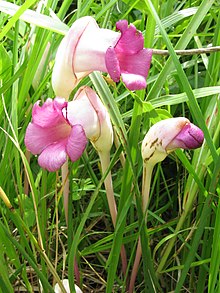

| Aeginetia | |
|---|---|

| |
| Aeginetia sinensis | |
| Scientific classification | |
| Kingdom: | Plantae |
| Clade: | Tracheophytes |
| Clade: | Angiosperms |
| Clade: | Eudicots |
| Clade: | Asterids |
| Order: | Lamiales |
| Family: | Orobanchaceae |
| Tribe: | Buchnereae |
| Genus: | Aeginetia L.[1] |
| Species | |
|
See text | |
| Synonyms[1] | |
| |
Aeginetia is a genus of plants in the broomrape family Orobanchaceae, native mostly to tropical Asia and also Cameroon (in Africa).[1]
It is found within Assam, Bangladesh, Borneo, Cambodia, southern China, East Himalaya, India, Japan, Jawa, Korea, Laos, Malaya, Myanmar, Nansei-shoto, Nepal, New Guinea, Ogasawara-shoto, Philippines, Sri Lanka, Sulawesi, Sumatera, Taiwan, Thailand and Vietnam.[1]
The genus name of Aeginetia is in honour of Paul of Aegina (c. 625 – c. 690), a Byzantine Greek born physician best known for writing the medical encyclopedia, Medical Compendium in Seven Books.[2] It was first described and published in Sp. Pl. on page 632 in 1753.[1]
As of May 2020[update], Plants of the World Online recognises the following species:[1]
| Aeginetia |
|
|---|---|